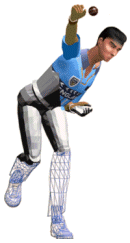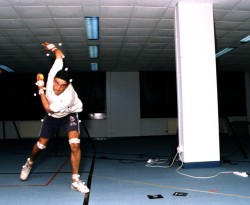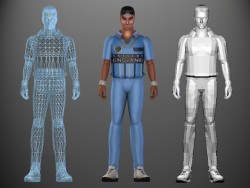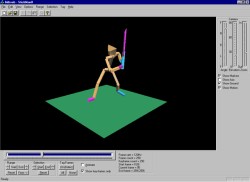

|
|

Motion capture is exactly as the name suggests. That is, the capturing of motion. The best way to imagine it is to think of a film shoot except that the cameras being used are capable of recording motion rather than light and that multiple cameras are required for each 'shot' as opposed to just one.
Well in the case of Cricket, the first step was to develop a comprehensive list of all animations required in the game. Once complete, we went on to hire some appropriate actors for the job. It was no use getting in any old Tom, Dick or Harry - it was essential that these guys not only knew how to play the game but knew how to play it well.
Motion capture studios can be set up in a variety of ways depending on the technology, the motion being recorded and the size of the area required for the motion. But with the motion capture technology we used, the general setup was as follows.

Three different sized areas were marked out in a large room : small, medium and large. Dotted around each of the different areas were several key camera positions. The small and medium areas each used 6 cameras while the large area used 8. The small area was used for motions like the bat strokes and the various standing poses, the medium area was used for the dives and the walks while the large area was used for all the running / bowling type motions. All natural sunlight and reflective surfaces were hidden away from the cameras.
Motion capture cameras aren't just any old cameras (and at about 25,000 pounds a piece you can understand why). In fact they can be more likened to 'bat' cameras. That is, through a series of infra red beams, they can measure the distance of objects away from them in the same way as a bat does with their sonar. This information is recorded at the rate of 120 frames per second which means that even the quickest of motions will still be recorded.
Motion capture actors wear a series of silver reflective balls strapped to key positions on their body - see the picture below. As they go through each of the actions, the positions of all of the balls are recorded. As long as a ball is visible by at least 3 cameras at any one time, the ball will have a position in 3D space.
 Once all the raw data is recorded, it must be processed into the appropriate form for us to use in the game. As the PC has various limitations that must be adhered to (for example, we cannot play back the animations at 120 frames a second), we need to sift through all this data and determine the key frames which we will be used in the game. The screen shots above show the tool we used to edit the data. We also need to do things like clean up the beginning and the end of each sequences (for example, when the actor is walking into position) and choose the best take to use in the game.
Once all the raw data is recorded, it must be processed into the appropriate form for us to use in the game. As the PC has various limitations that must be adhered to (for example, we cannot play back the animations at 120 frames a second), we need to sift through all this data and determine the key frames which we will be used in the game. The screen shots above show the tool we used to edit the data. We also need to do things like clean up the beginning and the end of each sequences (for example, when the actor is walking into position) and choose the best take to use in the game.
Once we have processed the final motion capture data, it must be applied to appropriate 3D models. In our case, we created 4 unique models of cricketers for the game including a batsmen, bowler / fielder, a wicket keeper and an umpire. The picture below shows an example of a wire frame model, a polygon model with textures and a polygon model without textures.
 It's not an easy process to incorporate motion capture technology into an interactive game but it is a process that guarantees more realistic animation. And as technology increases, the way in which the motion capture is utilised in the final product will only continue to go from strength to strength.
It's not an easy process to incorporate motion capture technology into an interactive game but it is a process that guarantees more realistic animation. And as technology increases, the way in which the motion capture is utilised in the final product will only continue to go from strength to strength.Copyright © 1997 - Beam International Ltd
Feedback - Comments - Questions